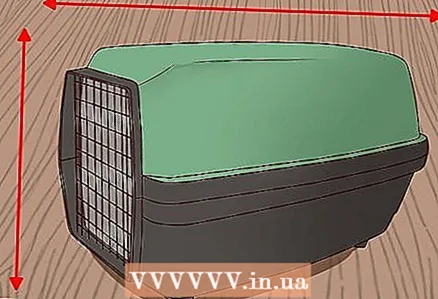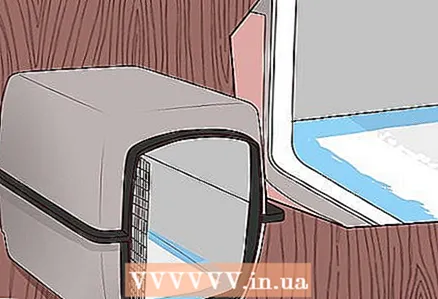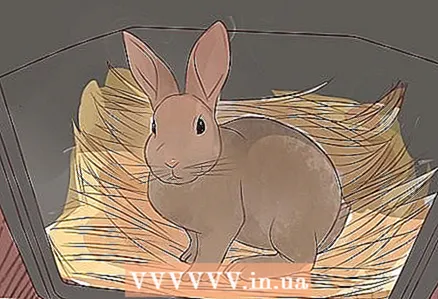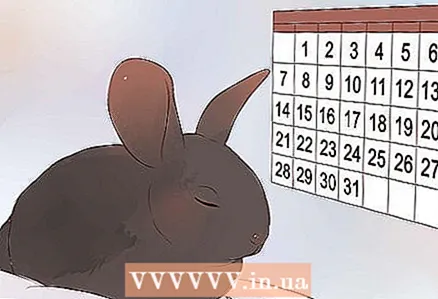
Content
- Steps
- Part 1 of 3: Selecting and Preparing a Suitable Carrier Cage
- Part 2 of 3: Transporting the rabbit
- Part 3 of 3: Set up in a new location
In general, rabbits don't really like leaving their own home. Therefore, before discussing transporting your pet, consider the validity of your desire to take your rabbit with you on your trip. Most rabbits can tolerate one or two days of travel, but staying outside their usual home for longer causes stress in the animals. It's okay to travel to the vet or to rabbit shows. It is also obvious that if you move yourself, the rabbit will simply have to move with you. But taking a rabbit with you on vacation or rolling around the city with him, as you can do with a dog, is completely unacceptable for such a pet. If you really need to transport your rabbit for any reason, there are some things to consider to ensure that your animal is transported safely and largely stress-free.
Steps
Part 1 of 3: Selecting and Preparing a Suitable Carrier Cage
 1 Buy a rabbit carrier. The rabbit carrier must be rigid, sturdy, well ventilated and secure so that the rabbit cannot chew through and escape. The carrier should also have an additional top door so that the nervous rabbit can be easily removed from it.
1 Buy a rabbit carrier. The rabbit carrier must be rigid, sturdy, well ventilated and secure so that the rabbit cannot chew through and escape. The carrier should also have an additional top door so that the nervous rabbit can be easily removed from it. - Cardboard boxes should not be used as carriers, as the rabbit can chew on them, and the box will lose its reliability if the rabbit urinates in it or it starts raining.
- Rabbit carriers can be found at local pet stores or ordered online.

Pippa Elliott, MRCVS
Veterinarian, Royal College of Veterinary Surgery Dr. Elliot, BVMS, MRCVS is a veterinarian with over 30 years of experience in veterinary surgery and companion animal care. Graduated from the University of Glasgow in 1987 with a degree in Veterinary Medicine and Surgery. Has been working in the same animal clinic in her hometown for over 20 years. Pippa Elliott, MRCVS
Pippa Elliott, MRCVS
Veterinarian, Royal College of Veterinary SurgeryPippa Elliot, Licensed Veterinarian, recommends using cages specifically designed for rabbits: “Do not carry rabbits in a cage that has been used for other animal species, such as cats. Cats are carnivores and rabbits are prey, so don't stress them too much. "
 2 Choose a carrier that is the right size for your rabbit. The carrier should be smaller than a normal rabbit cage, but large enough to accommodate all the rabbits being transported, so that they can lie down comfortably in any direction, and also turn freely. More than one rabbit can be transported in one carrier, but the cage must be large enough to provide comfort for all animals.
2 Choose a carrier that is the right size for your rabbit. The carrier should be smaller than a normal rabbit cage, but large enough to accommodate all the rabbits being transported, so that they can lie down comfortably in any direction, and also turn freely. More than one rabbit can be transported in one carrier, but the cage must be large enough to provide comfort for all animals. - Also, the cage should be small enough to provide the rabbit with a sense of security and to prevent the animal from bumping the walls while moving. It is desirable that the carrier has a partially covered part, which will create an imitation of a safe mink for the rabbit. If the cage is partially enclosed, make sure it is well ventilated.
 3 Line the bottom of the carrier with a non-slip, odor-absorbing material. The rabbit should not slip on the cage during transport, especially if the carrier has a smooth non-lattice bottom. And even if the bottom of the carrier is lattice, the rabbit will be uncomfortable to be directly on it for more than a couple of hours.
3 Line the bottom of the carrier with a non-slip, odor-absorbing material. The rabbit should not slip on the cage during transport, especially if the carrier has a smooth non-lattice bottom. And even if the bottom of the carrier is lattice, the rabbit will be uncomfortable to be directly on it for more than a couple of hours. - Disposable puppy diapers are great for covering your rabbit carrier. You can buy them at pet stores.
- You can also cover the bottom of the carrier with newspapers or towels, and then cover them with a layer of rabbit litter to prevent unpleasant odors. Many people who choose this path use special rabbit litter fillers or cheaper counterparts in the form of bird cage filler or cat litter based on pine sawdust.
- You can also lay a regular towel at the very bottom, and put a disposable diaper on top and an additional small towel or blanket to seal the space so that the rabbit slips less.
- Pine, cedar, or other aromatic sawdust can adversely affect your rabbit's health.
 4 Place the hay in the carrier and attach the drinker. Most rabbits do not tend to eat a lot during transport due to the increased stress, but the hay stored just in case can be a good snack for the pet. Do not put a regular food bowl in the carrier as it may injure your rabbit during transport. In most cases, the rabbit drinkers used for transportation (which you can buy at the pet store) come in a volume of 120-170 ml and can be easily attached to the wall of the carrier using the included spring with carabiners.
4 Place the hay in the carrier and attach the drinker. Most rabbits do not tend to eat a lot during transport due to the increased stress, but the hay stored just in case can be a good snack for the pet. Do not put a regular food bowl in the carrier as it may injure your rabbit during transport. In most cases, the rabbit drinkers used for transportation (which you can buy at the pet store) come in a volume of 120-170 ml and can be easily attached to the wall of the carrier using the included spring with carabiners. - Give your rabbit time to get used to drinking water from the transport drinker before transporting it. Also, try to use water from your home for your rabbit as much as possible during your trip. Rabbits can be finicky about changing water, and you don't need to dehydrate your pet at all, especially if the ride is going to last longer than a few hours.
- If during transport the rabbit refuses to drink from the drinker and at the same time someone is sitting next to him in the back seat of the car, ask that person to safely remove the rabbit from the carrier and pour some water into his palm so that the pet can feast on it.
- Some rabbits also refuse hay during transport. In this case, prepare a slice of celery or carrots for your pet.
 5 Allow your rabbit to examine the carrier before transporting it. Do not force your rabbit into the carrier to avoid stress or fear of it. Leave the carrier door open and lure the rabbit inside with a treat. Give your pet some time in the carrier with the door open so that it can go in and out of its own accord. It's best to do this a day or two before your trip so that the rabbit gets used to it and isn't afraid of being carried.
5 Allow your rabbit to examine the carrier before transporting it. Do not force your rabbit into the carrier to avoid stress or fear of it. Leave the carrier door open and lure the rabbit inside with a treat. Give your pet some time in the carrier with the door open so that it can go in and out of its own accord. It's best to do this a day or two before your trip so that the rabbit gets used to it and isn't afraid of being carried.
Part 2 of 3: Transporting the rabbit
 1 Secure the carrier to the vehicle seat with a seat belt or place it securely on the floor behind the front seat. It is necessary to avoid cell mobility during movement. Position the carrier with its side wall in the direction of travel so that the rabbit does not accidentally hit its muzzle when suddenly braking the car.
1 Secure the carrier to the vehicle seat with a seat belt or place it securely on the floor behind the front seat. It is necessary to avoid cell mobility during movement. Position the carrier with its side wall in the direction of travel so that the rabbit does not accidentally hit its muzzle when suddenly braking the car. - Never place your rabbit carrier in a locked trunk. It's too dark and scary, and the pet may run out of air to breathe!
- Rabbits can be transported on a covered loading platform or trailer, provided there is good ventilation. However, this should be avoided in hot weather as rabbits are sensitive to heat. Also, the carrier of the rabbit must be securely tied.
 2 Keep the car cool at all times. If it is hot outside, or even just warm, turn on the air conditioner in the car. Rabbits are more sensitive to heat than humans. Park in the shade during stops, and if it is hot outside, do not turn off the engine and leave the air conditioner running. In this case, you can take two car keys with you so that you can lock the car doors if you need to leave.
2 Keep the car cool at all times. If it is hot outside, or even just warm, turn on the air conditioner in the car. Rabbits are more sensitive to heat than humans. Park in the shade during stops, and if it is hot outside, do not turn off the engine and leave the air conditioner running. In this case, you can take two car keys with you so that you can lock the car doors if you need to leave. - If possible, arrange for a trip during cooler times of the day, such as in the early morning or evening, when the sun is already setting.
- It is unlikely that a rabbit will freeze in a car if the temperature is not freezing outside. If the outside temperature is safe enough for you, then the rabbit can safely stay in an unheated car.
 3 If it's warm outside, take the rabbit out of the car with you for the night. If you plan on staying at the hotel, check in advance that you will be allowed to take a rabbit carrier into your room. If hotels do not allow it, stop for the night only after sunset and the heat has subsided.
3 If it's warm outside, take the rabbit out of the car with you for the night. If you plan on staying at the hotel, check in advance that you will be allowed to take a rabbit carrier into your room. If hotels do not allow it, stop for the night only after sunset and the heat has subsided. - Lock your car doors at night, but leave the windows open enough to provide ventilation. Park in the shade so that the early morning sun does not stress and overheat your rabbit.
 4 Check the condition of the rabbit during the ride. Be sure to keep water in the drinker at all times. When you stop, offer treats like apples or carrots to your pet. They can be put directly into the carrier for the duration of the trip. The rabbit may refuse treats, but it is better to have them available. Just remember to remove them if they start to deteriorate.
4 Check the condition of the rabbit during the ride. Be sure to keep water in the drinker at all times. When you stop, offer treats like apples or carrots to your pet. They can be put directly into the carrier for the duration of the trip. The rabbit may refuse treats, but it is better to have them available. Just remember to remove them if they start to deteriorate. - Offer your rabbit a vitamin supplement such as Tetravit to increase the animal's stamina in stressful situations.
 5 Watch for signs of overheating. If your rabbit overheats, you will need to move it to a cooler area immediately, so make sure it is not exposed to the sun. Moisten his ears with cool (but not cold) water to help the animal's temperature return to normal. Another way to prevent your rabbit from overheating when air conditioning is not available is to keep plastic bottles of frozen water near the carrier. Symptoms of rabbit overheating include:
5 Watch for signs of overheating. If your rabbit overheats, you will need to move it to a cooler area immediately, so make sure it is not exposed to the sun. Moisten his ears with cool (but not cold) water to help the animal's temperature return to normal. Another way to prevent your rabbit from overheating when air conditioning is not available is to keep plastic bottles of frozen water near the carrier. Symptoms of rabbit overheating include: - frequent shallow breathing;
- hot ears;
- apathy;
- wet nose;
- throwing the head back with frequent breathing with an open mouth.
 6 Read in advance the rules for transporting animals of a particular airline if you are going to fly with your pet. Transporting a rabbit by air is permissible. If you are forced to take your rabbit with you on board the plane due to a move, find out in advance what will happen to him during such a trip.
6 Read in advance the rules for transporting animals of a particular airline if you are going to fly with your pet. Transporting a rabbit by air is permissible. If you are forced to take your rabbit with you on board the plane due to a move, find out in advance what will happen to him during such a trip. - Find an airline that allows pets. For example, this is allowed in airlines such as Russia and Aeroflot. All airlines have their own prices and rules for transporting animals, so gather all the information you need.
- Purchase a carrier suitable for air travel. You will have to check with the airline's requirements for the type of carrier in which it is acceptable to air your rabbit. Again, it all depends on the particular airline.
- Check the dates. In some cases, airlines only allow animals to be transported during certain months when such transportation is safe enough for them.
- Use the cargo cart to move around the airport with a carry.A rabbit carrier with a pet inside weighs a lot, so to move around the airport, it would be better to use a cargo trolley and securely install the carrier itself on it.
Part 3 of 3: Set up in a new location
 1 Give your rabbit time to get used to it. It will take a rabbit time to get used to a new location, be it temporary or permanent. He may become not so friendly or withdraw into himself during the acclimatization period due to the stress suffered during transportation. After a while, out of curiosity, he will begin to study the environment, let it happen at his own request, do not force the pet to do this.
1 Give your rabbit time to get used to it. It will take a rabbit time to get used to a new location, be it temporary or permanent. He may become not so friendly or withdraw into himself during the acclimatization period due to the stress suffered during transportation. After a while, out of curiosity, he will begin to study the environment, let it happen at his own request, do not force the pet to do this.  2 Make the most of your rabbit's environment. Return the rabbit to its normal crate as soon as possible after transport, or arrange a room for it in the same way as you did at home. Feed your pet the same food as before and provide familiar toys. Take the time to talk and pet your pet as you did at home.
2 Make the most of your rabbit's environment. Return the rabbit to its normal crate as soon as possible after transport, or arrange a room for it in the same way as you did at home. Feed your pet the same food as before and provide familiar toys. Take the time to talk and pet your pet as you did at home.  3 Watch for signs of ailments. Due to the stress experienced during transport, you will need to monitor the rabbit's health for some time. Since rabbits in nature are prey for predators, they tend to hide their diseases and injuries. If you think your rabbit is sick, you will need to see your veterinarian as soon as possible. Signs of ailments include:
3 Watch for signs of ailments. Due to the stress experienced during transport, you will need to monitor the rabbit's health for some time. Since rabbits in nature are prey for predators, they tend to hide their diseases and injuries. If you think your rabbit is sick, you will need to see your veterinarian as soon as possible. Signs of ailments include: - teeth grinding (especially in combination with a twisted posture, which is a symptom of pain);
- tilted head;
- breathing with an open mouth;
- the appearance of blood in the urine or anywhere in the cell / house;
- lameness or paralysis;
- enlargement and soreness of the abdomen;
- sounds (screams);
- decreased appetite or thirst for more than two days after the end of the trip;
- drooling, drooling, hair loss on the chin (all this indicates dental problems);
- nasal discharge, sneezing or coughing, difficulty breathing (indicates a respiratory infection);
- changes in stool (appearance of diarrhea or constipation);
- hair loss, itching, flaking of the skin, skin tumors;
- attempts to bite, growl or attack (which indicates a strong pain in a usually affectionate pet).



